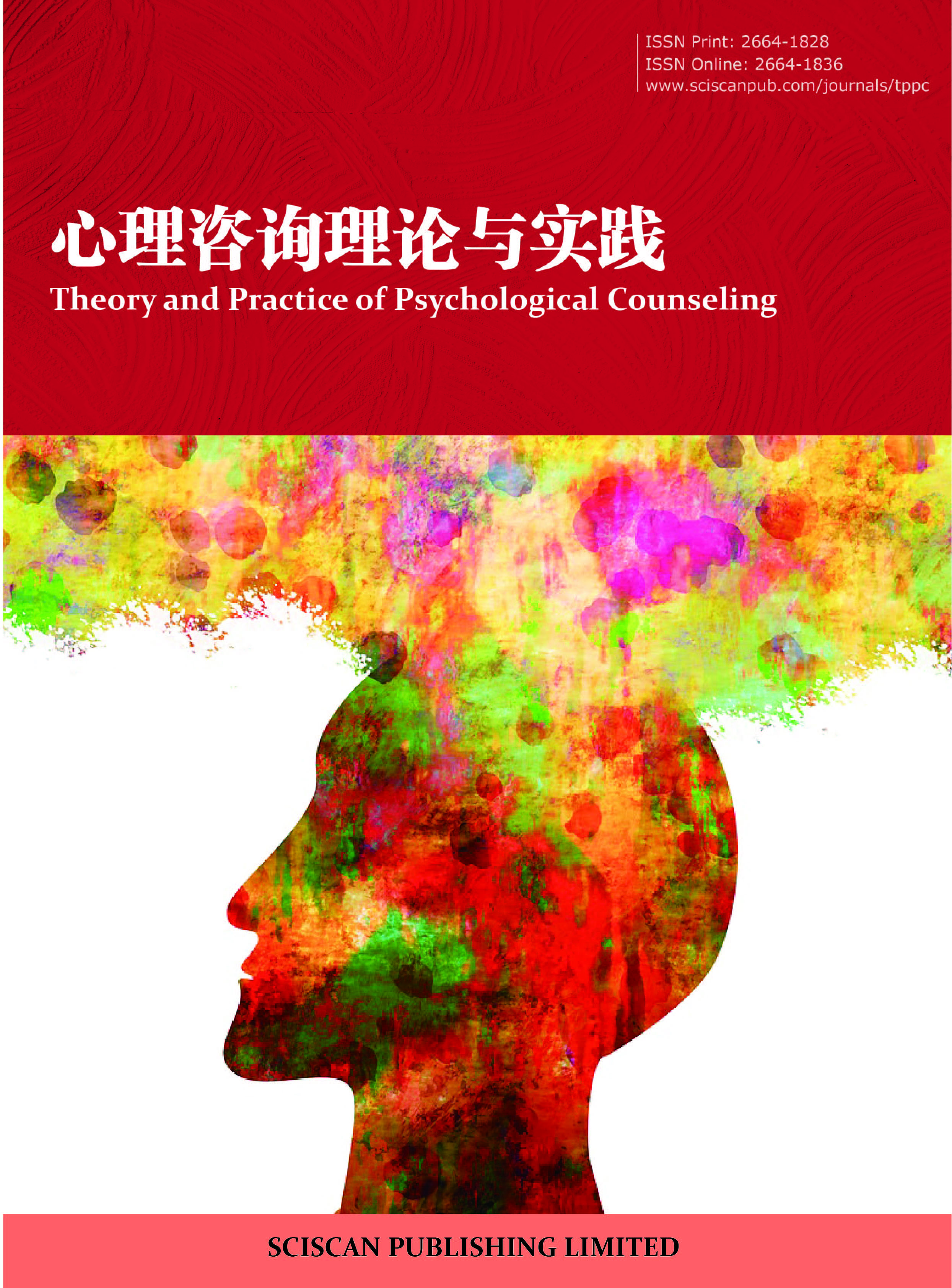Theory and Practice of Psychological Counseling
放松与心理治疗设置
Relaxation and Therapeutic Settings
- Authors: 赵丞智
-
Information:
北京曼陀海斯心理咨询中心,北京
-
Keywords:
Paradigm; Relaxation; Therapeutic settings; Psychoanalysis; Psychotherapy; Winnicott范式; 放松; 治疗设置; 精神分析; 心理治疗; 温尼科特
- Abstract: In clinical practice, one of the most common issues encountered by therapists is the patient’s tension and inability to relax, particularly during the early stages of therapy. Before applying analytic therapeutic techniques, this issue of relaxation must first be considered, adapted to, and addressed within the therapeutic settings. This article aims to explore the relationship between the therapeutic settings and the patient’s need for relaxation from the perspectives of Freud’s psychoanalytic paradigm and Winnicott’s psychoanalytic paradigm. The focus of this article is on how, under the theoretical guidance of Winnicott’s concepts regarding the therapeutic settings and the illustration of a clinical case, therapists can conceptualize and implement adjustments to therapeutic techniques. This is intended to help patients develop the ability to relax and further their personal growth. 在临床实践中,尤其是治疗的早期阶段,治疗师最常遇到的一个问题是病人感到紧张和无法放松。在采用分析性治疗技术之前,治疗设置中应首先考虑放松的问题,并进行相应的调适。本文试图从弗洛伊德精神分析范式和温尼科特精神分析范式的视角,分别探讨治疗设置与满足病人放松需求之间的关系。进而,本文基于温尼科特的治疗设置理论,结合临床案例材料,帮助治疗师构思、调整并实践治疗技术,促进病人发展出放松的能力并实现进一步的持续发展。
- DOI: https://doi.org/10.35534/tppc.0703009
- Cite: 赵丞智.放松与心理治疗设置[J].心理咨询理论与实践,2025,7(3):73-81.
心理治疗要解决的是文化对个体和家庭造成的问题,但同时往往也会受到文化的影响。中国文化在家庭养育方面历来重视对孩子的教导和训练,随着时代的发展,这种重视在当今社会呈现出不断强化的态势。正如中文谚语所说:“没有规矩,不成方圆。”近年来,随着社会竞争的加剧,许多父母急于看到孩子的“成长”和学业成就,过早地为孩子设置了许多规矩,并提出了过多的要求。父母们往往对孩子从小就抱有很高的期待,许多督促和教育行为的背后,其实隐藏着父母对社会压力的焦虑和对孩子未来不确定性的担忧和恐惧。一些家长可能对“不确定性”(the uncertainty)和“无定性”(the formlessness)状态缺乏足够的耐受力,因此无法给予孩子发展所需的充分观察和等待。为了缓解自身无法耐受的焦虑感,父母们更倾向于通过早教和培训活动帮助孩子在竞争中占据优势,而这些行为在很大程度上取代了真正的养育活动。
然而,这种以父母为代表的家庭环境的急切心态不仅体现在家庭养育中,也同样出现在许多心理治疗的环境之中。治疗师经常被青少年的家长影响也无法放松,急于看到青少年病人的好转和进步,对病人有很高的期待,制定了严格的治疗设置和治疗计划,并进行了过多的干预。因此,帮助病人放松应是治疗师首要关注的问题。本文对比研究了弗洛伊德精神分析设置和温尼科特精神分析设置中关于放松的不同方式和意义。
1 “放松”在温尼科特范式照护治疗中的意义
首先,从温尼科特精神分析范式的角度,探讨治疗中病人的放松状态及其意义,以及治疗设置如何为病人的“放松”提供支持。因为只有当病人在一定程度上放松下来,才有可能获得进一步的治疗性收获。
温尼科特认为,病人在治疗设置中首先需要“放松”下来,这是一种“基于体验的信任条件下的放松状态”(Winnicott,1971:74)。这种“基于体验的信任”是在治疗性人际关系的设置中产生的,它要求治疗师首先具备放松的能力,不对病人抱有过高期待,并能够建立和维持一种特殊的治疗设置。这个设置从一开始就需要顾及病人的主观世界,尽可能成为病人主观世界中的客体,让病人获得一种人际关系中的真实感受。只有在这样的条件下,病人才能逐渐进入一种基于信任的放松状态,而治疗的效果也才有可能逐步得以实现。
温尼科特认为,“放松”(relaxation)是“整合”(integration)的对立面。也就是说,个体的放松状态一定是在其不发生整合或不尝试整合的状态中出现的。放松状态与病人能否放弃“行动化”防御并安静下来密切相关。因此,放松不仅仅是指放弃“主动的心智思考”,更重要的是能够让自己的精神-躯体性状态进入一种安静、不行动、不挣扎的状态,放弃整个精神-躯体性的僵化和紧张。这种放松实际上是一种精神-躯体性的放松体验,是“……病人需要在专业性设置中获得的一种新体验。这是一种非目的性状态的体验,……是一种非整合人格的缓慢运转状态。我称其为是一种‘无定形’(formlessness)的状态”(Winnicott,1971:55)。
因此,温尼科特认为的“放松”状态并非单纯的心智放松,而是一个精神-躯体性整合逐步松解的过程。他认为,真正的放松状态是指个体处于一种精神-躯体性“无定形”(formlessness)和“无目的性”(non-purposive state)的状态。在这种状态下,个体进入一种非整合的自由和放松状态,僵化和紧张的假自体防御逐渐退去,真自体的自发性和创造性冲动才有可能逐渐浮现在治疗关系中。正如温尼科特所说,只有这种放松状态“才会为不相关联的想法连续出现腾出空间”(Winnicott,1971:55)。这种放松状态是病人在治疗师的陪伴下,在特定的治疗设置中逐渐出现的。它不是一蹴而就的,而是一个需要时间和信任积累的过程,最终为病人通向真自体的体验创造了可能性。
由此看来,病人的放松状态是在治疗设置中与治疗师共同实现的。在精神分析性临床实践中,存在两种不同范式的治疗性设置:一种是弗洛伊德精神分析范式的设置,另一种是温尼科特精神分析范式的设置。这两种设置的主要态度取向是相反的——前者是一种挫折或剥夺性设置,而后者是一种适应或照护性设置。然而,这两种设置在临床实践中并不是绝对对立的,很多时候它们是相互转换和相互补充的。这种选择取决于病人当下的状态和需求。正如温尼科特所指出的:“不健康的人格部分在任何人的人格中都起着相同的作用,而我们无论如何都不能因为知道病人还有相当多的健康人格部分,从而减少对病人需求的适应。”(Winnicott,1964/1989:100)特别是对于那些精神病性和边缘性人格的病人,“我们要处理的是不健康的那部分人格,把这部分的疾病看得多么严重都不为过。”(ibid:100)因此,在面对这些病人时,治疗师需要更加注重适应性和照护性的设置,以帮助病人逐渐进入放松状态,从而为进一步治疗性变化创造条件。
2 弗洛伊德精神分析范式的治疗设置和放松
在经典精神分析范式中,治疗设置往往带有挫折和剥夺病人欲望的意味,其目的在于让移情材料在治疗关系中得以暴露,从而成为分析的对象。因此,在经典精神分析中,治疗设置被视为一种理所当然的规范性原则,治疗师与病人的工作必须严格遵循这些既定原则。治疗设置被认为不能随意突破,治疗师也不需要对设置本身进行调整。如果这些原则被打破,那么神经症性移情就无法形成,治疗工作也将因此无法进行。
这些规范性设置包含许多具体要求,其中一个广为人知的例子是病人和治疗师座椅的安排。这一原则要求病人必须躺在长沙发上,而治疗师则坐在病人头部的后方,完全不出现在病人的视线范围之内。事实上,即便是在弗洛伊德的时代,许多病人也并不喜欢这种座位安排。他们希望能自由选择自己的座位或谈话姿态,但这些要求在治疗中是被否决的。最终,在治疗师的规劝下,大多数病人从一开始就按照要求乖乖地躺在长沙发上接受分析。弗洛伊德曾经说过:
“特别多的病人反对被要求躺下,而治疗师也要坐在他们看不见的后面。病人们会要求治疗师允许他们以其他姿势接受治疗,很多情况是因为他们被剥夺了看见治疗师的机会而感到很焦虑。但这种要求通常会被治疗师拒绝。”(Freud, S.,1913(12):138)
另一项规范性原则是,病人不能保持沉默,必须在治疗中说话和表达。沉默被视为对治疗的一种阻抗,是需要被分析和讨论的重要材料之一。因此,许多病人在治疗中不得不说话,甚至会提前准备好治疗中要谈论的话题,主动承担发起谈话的任务。然而,对于许多病人而言,这一规定无形中增加了他们的精神紧张,使得他们难以在治疗中放松下来。同时,这一规定还为病人逃入理智化谈话提供了机会,这样就加强了病人的心智防御,让他们成功地避开了在治疗关系中直面人际情感冲突的困难。更复杂的情况是,这种以理智化为特征的心智防御往往会与治疗师的心智防御形成一种共谋,使得情感卷入被回避。对此,弗洛伊德曾经指出:
“……但在任何情况下,(治疗师)都必须让病人自己说话,并且病人必须自由选择从什么地方开始。因此,我们要对病人说:‘在我能对你说什么之前,我必须了解你的很多情况;请你告诉我你对自己了解多少。’”(Freud,S.,1913(12):134)
弗洛伊德的一个重要贡献是将“自由联想”(free association)作为恢复病人压抑无意识记忆材料的一种技术,以代替催眠技术的使用。弗洛伊德对“自由联想”这个技术的使用做出了非常严格的规定性设置。通常在治疗一开始,治疗师便会要求病人以一种不同于日常谈话的方式进行自由联想。这一规定性陈述往往显得过于冗长和正式。此外,治疗师还会要求病人基于自由联想的材料探索出其中的意义。对此,弗洛伊德曾详细地说明对自由联想的要求,明确了病人在治疗中需要遵守的原则。他指出:
“这一点必须在一开始就告诉病人:‘在你开始之前,有一件事你需要知道。这里与你的日常谈话不同,你跟我的谈话需要采取另一种方式。通常情况下,你会尽量保持整个谈话思路的连贯性,并试图排除任何可能的闯入性想法或看似无关紧要的问题,以免偏离原本的主题。然而,在你和我的谈话中,你需要做出改变。你会注意到,当你开始叙述事情时,各种各样的想法会浮现在你的脑海中,但你可能会因为某些批评和反对的理由而将它们搁置一边。你可能会对自己说‘这个想法似乎与我们的谈话无关’,或者‘它完全不重要,甚至显得荒谬’,于是你决定不提及它们。但是,你绝不能对这些评价妥协。无论这些想法显得多么无聊、荒诞或不相干,你都必须毫无保留地说出来——事实上,那些你有抗拒或感到不愿说出来的内容,正是你必须要报告的内容。稍后,你会逐渐明白并学会理解这一规则存在的原因。这是你在治疗中唯一必须严格遵守的原则。所以,你需要毫无保留地说出你脑海中出现的任何内容。举个例子,就好比你是一位旅客,坐在火车车厢的窗边,向车厢内的人描述透过窗户看到的外面不断变化的景象。最后,请永远记住你曾经承诺过要完全真诚,不因任何原因遗漏任何内容,即使它让你感到不愉快。’” (Freud,S.,1913(12):135)
当然,弗洛伊德在设定“自由联想”(free association)这一技术的操作性规定时,也考虑到让病人处于一种放松状态。作者认为,他强调的是病人在“心智思考”(mind thinking)层面的“放松状态”。他说道:
“我要求我的病人承诺并保证克制住任何意识性反思,并放弃他们自己,处于一种安静的专注状态,跟随他们自发(不随意)性产生的各种想法,即那些‘掠过他们意识表层’的想法。”(Sigmund Freud,1924(19):195)
这实际上是一种单纯在心智思考层面的放松状态,而且还是对病人提出的要求。弗洛伊德期待病人克制住任何意识性思考,调动他们的专注功能,通过跟随那些出现在脑海中的“自由想法”,来探寻病人忘记的(压抑的)无意识记忆材料。然而,对于某些病人来说,这些“自由想法”并非真正自由,而是病人经过一定心智功能操作后定义的。因为“当所有的意识性理智目的已经被压抑时,浮现出来的任何想法会被认为是由无意识材料决定的”。(ibid:195)
此外,对于那些患有严重焦虑或需要防御不安全感的精神紧张的病人来说,他们可能会将“自由联想”体验为一种来自治疗师的要求,反而感到更加紧张。因此,单纯在心智思考层面的放松并不是真正的放松状态。在这种状态下,自由联想甚至可能变成一种心智防御机制。病人为了迎合治疗师的要求,可能会报告一些经过心智加工后的言语材料,“分析师才能够辨识并指出自由联想材料中不同部分之间的某个(或某些)联系。”(Winnicott,1971:55)而这些言语性材料极有可能并非真正来自无意识。
在经典分析性治疗中,还有许多规定性的原则需要在治疗一开始就向病人明确提出。这些规定对于许多病人来说,可能会在心智层面上增强他们对治疗师权威的信任感,但与此同时,这种做法也很容易在很大程度上妨碍他们在治疗关系中的放松状态。此外,这些严格的规定还可能严重影响病人对治疗师情感信任的建立与发展。
3 温尼科特精神分析范式的治疗设置和放松
与此相对,在温尼科特的精神分析范式中,治疗设置不再是一种规定性原则的宣布与要求,而是变成了一种以适应性构建为核心的原则。换句话说,治疗设置是根据病人在不同成熟阶段的需求,按照发展性原则建立和维护的。因此,构建和维护治疗设置成为心理治疗工作的关键部分。
在温尼科特的范式中,许多情况下,治疗设置的管理与处理分析性材料的分析工作被视为同等重要。尤其是在治疗过程的初期,分析工作的重点往往发生转向,治疗设置的建立与管理被优先考虑。这是因为,在温尼科特的理论中,既不存在一种可以向病人直接宣布的规定性原则,也不存在一种理所当然、固定不变的设置。治疗设置的核心,在于对治疗关系中一切行为细节的具体管理。对此,温尼科特曾指出:
“如果(病人)有了一个完整的自我,那么分析师可以理所当然地认为,这些婴儿照护的早期细节已经拥有过了,那么分析性设置(的管理)相对于解释工作来说就是不重要的。(关于设置,我指的是所有管理细节的总和。)即便如此,在通常的分析过程中,所有的分析师通常或多或少都会接受某种基本比例的管理。”(Winnicott,1955-56/1958:297)
因此,在心理治疗一开始,治疗设置的建立首先需要围绕病人的“精神-躯体性放松”这一核心目标展开,通过提供适当的供养和管理来实现。这要求治疗师能够准确判断病人当前所处的成熟度、发展阶段以及成熟需求,同时深入了解病人早期的创伤性情境。如果病人无法在治疗关系中逐渐放松下来,那么分析性治疗工作将难以取得实质性进展。事实上,在某些情况下,帮助病人在治疗中达到放松状态,甚至会成为治疗性工作的主要任务和重要成就,且可能贯穿相当长的一段治疗过程。对此,温尼科特指出:
“只有在基于信任和接纳的治疗性设置中(无论是精神分析、心理治疗、社会工作还是其他结构化工作等领域),凭借职业可靠性所构建的安全感,病人才能逐渐进入放松状态。这种放松状态会为毫无关联性的一系列想法腾出空间。而分析师的任务,仅仅在于接纳病人这些看似毫无关联的想法,而不需假定其中一定存在某种有意义的线索。”(Winnicott,1971:54-55)
因此,“放松”实际上可以被视为一个重要的标志,用来衡量心理治疗操作性临床设置的效用。换句话说,在临床心理治疗过程中,当病人的假自体防御的紧张度与僵化性开始逐步松解时,病人便进入了放松状态。这种放松状态意味着病人的假自体防御逐渐退却,而真自体的自发性和创造性需求开始浮现于治疗关系中。由此可见,达成放松状态为病人重新启动其成熟过程创造了条件和机会。这一过程要求治疗师和病人共同建立一种安全、可靠、可及并可用的治疗性设置。正如温尼科特所说:
“分析师提供足够好的适应所产生的一种结果,正是治疗所找寻的结果;也就是说,病人的主要运作场所从假自体转移到了真自体。现在,在病人的生活中第一次出现了一个发展自我的机会,一个从自我核心进行整合的机会,一个建立身体自我的机会,也是一个启动客体关联性而拒绝外在环境要求的机会。于是自我第一次能够体验本我冲动,而且能够在这种体验冲动中和从这种体验所致的休息(放松)中感到真实。”(Winnicott,1955-56/1958:298)
4 温尼科特范式早期治疗设置的建立
温尼科特范式的治疗模型是以母婴照护关系为基础的模型。在这一模型中,治疗师需要在情绪成熟过程理论的指导下,具备亲自参与治疗性移情关系的能力,并根据病人的发展性需求,在设置的各个细节上进行促进性工作。同时,治疗师需要有能力进入病人的主观性世界,成为病人的主观性客体,首先与病人建立主观性关联。一开始,治疗师几乎需要绝对适应病人主观性自我关联的需求,为病人提供放松和供养的条件,帮助病人重新开始建立客体关联,直至病人发展出对客体的客观知觉。正如温尼科特指出:“对于某些具有特定诊断类型的病人来说,供养和维持治疗设置要比解释性工作更加重要。”(Winnicott,1964/1989:96)
在治疗这些病人的早期阶段,治疗设置的建立与维持首先并非直接针对病人所呈现的材料和表达方式,而是着眼于如何适应病人最初的成熟性需求。这样做的目的是帮助病人在治疗关系中首先获得对治疗师信任的希望,从而逐渐放松下来。因为“对于病人的这些需求将会在治疗中被满足这件事,病人只能逐渐开始获得希望”。(Winnicott,1964/1989:97)
在这样的治疗中,早期治疗设置的主要特点包含两个关键元素:安全性和可靠性。
首先,治疗设置的安全性不仅依赖于对时间和空间设置细节的管理,还依赖于治疗师对治疗中发生事件和病人需求的解释方式。这种解释需要帮助病人尽快意识到,他们在生命早期养育中所匮乏的或尚未被给予的东西。许多情况下,病人的这些需求会通过与治疗师的人际互动细节表现出来。例如,病人可能需要一种放松的人际氛围,因为他们感到紧张。这就要求治疗师在情绪和行为上首先放松下来。治疗师不能对病人表现出任何要求;不能显得过于聪明或表现出“知道得太多”;不能流露出任何权威性。同时,治疗师需要专注倾听病人的人生故事,允许病人在沉默中停留,而不急于给予解释。治疗师还需要真诚、投入地扮演病人指定的角色,尊重病人的选择和防御,并给予足够的时间和耐心去等待病人的自然进展。作者在另一篇文献中说:“只有在治疗师保持沉默并维持可靠的治疗框架时,那些内心充满兴奋和紊乱的病人才可能逐渐安静下来并放松,从而让他们的自发性和创造性冲动浮现出来,同时也为治疗师创造与病人建立深层联系的机会。”(赵丞智,2025:17)
当然,治疗设置的可靠性同样至关重要,这一点在很大程度上与治疗师的个人性格特质直接相关。所谓设置的可靠性,指的是治疗师需要以一种高度细致、可及且可用的行为方式,以及始终如一的态度,去适应和满足病人在早期治疗阶段或退行阶段对设置可靠性的需求。这种可靠性主要体现在治疗师的人格稳定性和专业的可靠性上。正如温尼科特所说:
“……在为这个病人预留出的治疗时间里,治疗师要具备一种专业的可靠性,这种可靠性与一个人自身的不可靠性格截然不同。”(Winnicott,1964/1989:100)
治疗师必须具备极大的耐受力和抱持能力,能够容忍并抱持住病人的摧毁性攻击,同时对治疗性情境和设置(包括治疗师本人的负性情绪)进行抱持和管理。在这种治疗设置中,一个有利于病人放松的关键特点是:治疗师需要向病人让渡出时间和空间,并按照病人的需求去适应和响应病人。治疗师需要让病人处于一种支配地位,允许病人主动开启治疗过程。同时,治疗师需要具备等待的能力,并乐意让自己处于一种准备好响应病人需求的待命状态。这就要求治疗师克制自己的冲动,少做解释或不做解释,而回报则是病人会逐渐放松下来,并能够自己做出解释。
总之,温尼科特范式的治疗设置以病人的放松为首要工作目标。这一设置在很大程度上依赖于治疗师的人格稳定性和专业可靠性,包括设置的稳定性、可靠性、可及性和可用性,以及治疗师对病人的允许和承诺。同时,治疗师需要具备抱持不确定性和无定形性状态的能力,为病人的放松和发展提供安全的治疗设置。
5 案例材料
在温尼科特范式的治疗过程中,治疗师通常需要花费一段较长的时间,专注于病人不能放松的问题。这种不能放松的状态实际上反映了病人缺乏自体自发性和自体真实感的问题。病人通过一种紧张和僵化的假自体应对行为,维持着一种虚假的自体存在感。这种防御形式不仅紧张而僵化,还伴随着深刻的痛苦感,包括与他人和世界的隔离感和不真实感。这类病人在临床层面通常表现出情绪和行为的强烈紧张性和高度警觉性。他们可能表现为敏感多疑、不停地主动说话或行动,或者长时间处于紧张性不语的状态。他们的身体动作和姿态常常显得不协调,伴随着强烈的紧张、害怕、羞耻和不安全感。在生活中以及治疗过程中,他们往往无法放松,害怕进入一种安静的休息状态,或者害怕沉默。他们可能会在治疗中回避与治疗师的情绪性接触,表现为脑海中想着治疗室之外的事情,或者处于一种幻想化防御状态,或者不停地说话,用自己的语言填满整个时空。
这种病理性行为模式的背后,是病人由于恐惧而试图远离治疗关系中可能激发的情绪和冲突。他们害怕面对自己的情感和人际关系,因此通过僵化和刻板的行为与思考来保护自己。这种僵化的防御使他们无法进行自由的表达和思考,也阻碍了他们在治疗关系中体验到真正的放松和安全感。
下面呈现一个案例材料和治疗中的片段,从中可以看到病人典型的“不能放松”状态,以及他在治疗关系中的困境:
一位30岁左右的男性病人,已经接受治疗一段时间了。病人表现出高度的警觉性和紧张感,伴随着一种刻板和僵化的行为模式,比如准时到来、准时结束、言语很少,以及无法专注于治疗关系中的当下,而是沉浸在与治疗无关的幻想中。这些幻想(如关于自己是武功高强的人并打败对手的场景)实际上是一种幻想化防御,帮助病人逃避当下的紧张和不安,同时也反映了他对自体感的缺失和对真实关系的回避。病人对自己不能投入到治疗关系中也非常着急,对自己不停地幻想而感到不安和羞耻,认为是在浪费时间,但又无法克制。
这次治疗病人也是准时到来,坐在单人沙发上,沉默不语,眼睛不停地观察着治疗师,感到紧张和不安,不停地在沙发上变换体位,似乎想找到一个舒服的位置,既不知道如何开始交流,也不知道交流什么内容。
在这个过程中,治疗师保持关注,但没有主动打破沉默,而是给予病人时间和空间。这种不急于填补空白的态度,体现了温尼科特范式的治疗设置特点——治疗师容忍不确定性,抱持病人的不安和紧张,为病人提供一个安全的环境,允许病人逐渐进入放松状态。
大约过了10分钟,病人开始说话:
病人:我可以把鞋子脱掉吗?
治疗师:可以的。
(病人开始脱鞋,期间不断地用眼睛余光看我,把双脚放在地板上感受,过了5分钟。)
病人:我,我可以脱掉袜子吗?
治疗师:可以的。
(病人开始脱袜子,边脱袜子边看着我,然后把双脚放在地板上。)
病人:我洗脚了,没有味道。
治疗师:是的,不过没关系。
病人:我可以站起来走一走吗?
治疗师:当然可以了!
(于是病人站了起来,在治疗室地板上走来走去,大约走了几分钟之后,坐在了单人沙发上。)
病人:在我小时候,妈妈不允许我光着脚在地上走,发现我光脚走路,她会生气并打我。
治疗师:在这里你可以做你想做的事情。
(病人开始沉默。)
病人:我的上一个治疗师把我抛弃了,就因为我在治疗中脱鞋了。
治疗师:因为脱鞋而被治疗师抛弃,就像被妈妈打了一顿,不要你了。
病人:我问她为什么抛弃我?她说她的督导师说我是精神病,让她终止跟我的治疗。
治疗师:她们可能都和你妈妈一样,都不允许你做你想做的事情。在这里,你可以做你想做的事情!
这段治疗片段的关键点是,病人的紧张和不安不仅是表面行为,更是他内在冲突、恐惧和防御的体现。治疗师的耐心和等待,以及简单的解释,为病人提供了一个包容和宽松的环境,让他有机会去体验过去生活中不敢体验的自发性冲动,从而获得一种安全感。
在之后很长一段时间的治疗中,这个病人反复询问:“我可以坐在地板上吗?”“我可以躺在地板上吗?”“我可以喝水吗?”“我可以吃东西吗?”“我可以休息一会吗?”大约过了两年时间,病人可以安静地躺在长沙发上,甚至在治疗中可以入睡一会儿。在此之前,病人30年来几乎在白天没有进入过休息和睡眠状态。
来到治疗室的绝大多数病人,其实都愿意首先与治疗师建立信任感,至少想尝试建立信任。如果治疗师首先能够放松下来,为病人提供一种有利于放松的环境,就能让病人恢复到曾经的“无定形”状态,也就是放松状态。“创造性是放松之后的一种聚集,而放松恰是整合(integration)的对立面。”(Winnicott,1971:63-64)这类病人只有从放松状态中“才可以从‘无定性’状态中感觉到有所成就的希望来自他对分析师的信任……而他童年的环境不允许他处于一种‘无定形’状态,正如他感受到的那样,他必须按照别人构想的模样去模式化自己,塑造自己。”(Winnicott,1971:33)
另外,温尼科特独创性地为精神分析引入了又一个悖论性主题——“无意义言语”的价值(the value of nonsense)。这个主题在我们的临床治疗中反复得到验证。当病人逐渐尝试放松下来的时候,他们很多时候会说出一些没有意义的话,或者发出一些没有意义的声音,甚至做出一些无法理解(没有意义)的与时间和空间有关的事情,比如不按时应约、不能按时离开、脱鞋、坐在地上、挪动座位和座椅、闭目休息等。在一段时间内,病人的言行其实是无意义的,它们只是在尝试进入一种放弃僵化和紧张防御的放松状态,治疗师没有必要从中识别出任何意义。也就是说,病人在照护性治疗设置之中,已经开始浮现出一种无定形性和无时空意义的放松状态。病人需要治疗师尊重这种无定形和无时空意义的不确定性状态,并接受这种状态,以帮助和促进病人找到与他自己的自发性和创造性相关的真实自体体验。
所以,治疗师要切记,针对那些缺乏自体身份感的病人,使用“自由联想”技术,要求他们寻找出联想材料之间的意义,实际上可能会加重病人的僵化性防御,妨碍病人进入一种安静的放松状态,这有可能是一种治疗性侵入。
致谢
感谢天津大学心理健康教育中心刘新春老师为本文提供的宝贵意见。
参考文献
[1]Freud S.A Short Account of Psychoanalysis in The Standard Edition[M].1924(19).
[2]Freud S.On Beginning the Treatment in The Standard Edition[M].1913(12).
[3]Winnicott.Playing:Creative Activity and the Search for the Self[M]//Playing and Reality.London:Tavistock Publications,1971.
[4]Winnicott.The Importance of the Setting in Meeting Regression in Psycho-Analysis[M]//Psycho-Analysis exploration,1964/1989.
[5]Winnicott.Clinical Varieties of Transference,Through Pediatrics to Psycho-Ananlysis[M].1955-56/1958:297.
[6]赵丞智.基于温尼科特理论:临床心理治疗中沉默技术的运用探究[J].心理咨询理论与实践,2025,7(1):12-24.
















